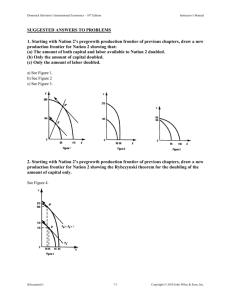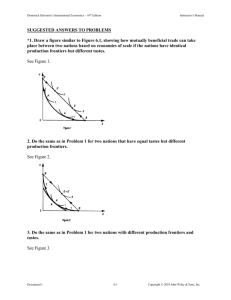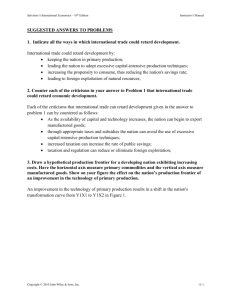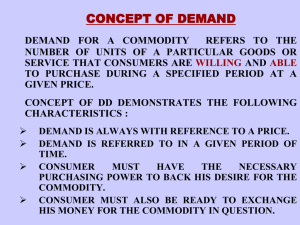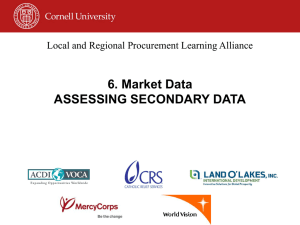Chapter 5 Book Answers
advertisement
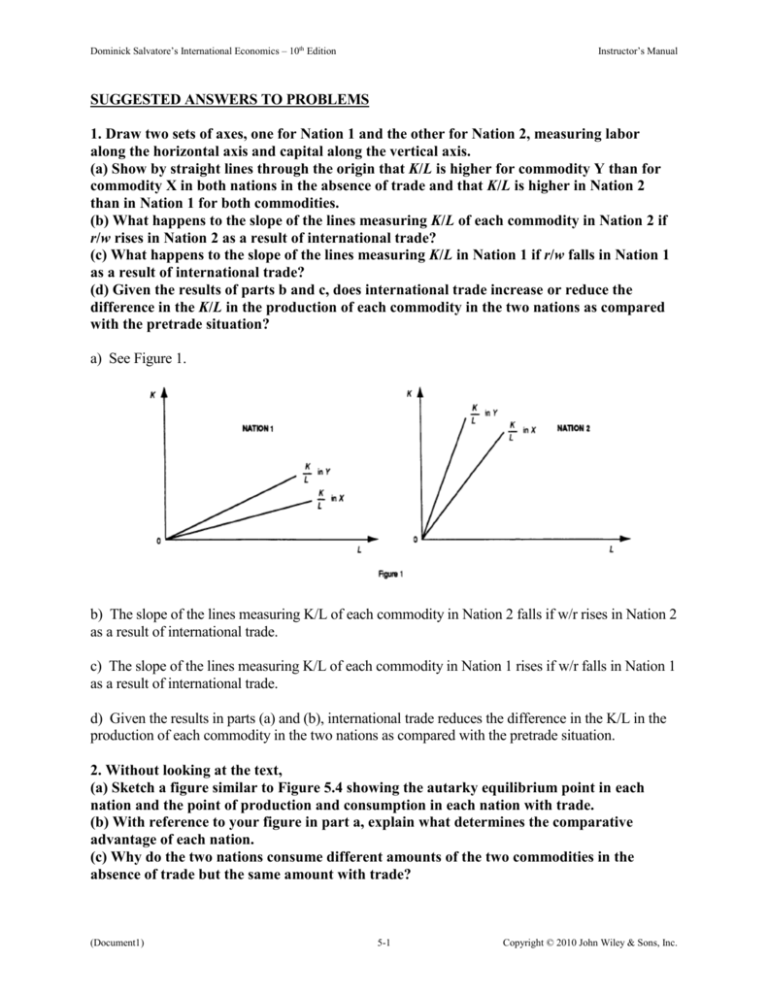
Dominick Salvatore’s International Economics – 10th Edition Instructor’s Manual SUGGESTED ANSWERS TO PROBLEMS 1. Draw two sets of axes, one for Nation 1 and the other for Nation 2, measuring labor along the horizontal axis and capital along the vertical axis. (a) Show by straight lines through the origin that K/L is higher for commodity Y than for commodity X in both nations in the absence of trade and that K/L is higher in Nation 2 than in Nation 1 for both commodities. (b) What happens to the slope of the lines measuring K/L of each commodity in Nation 2 if r/w rises in Nation 2 as a result of international trade? (c) What happens to the slope of the lines measuring K/L in Nation 1 if r/w falls in Nation 1 as a result of international trade? (d) Given the results of parts b and c, does international trade increase or reduce the difference in the K/L in the production of each commodity in the two nations as compared with the pretrade situation? a) See Figure 1. b) The slope of the lines measuring K/L of each commodity in Nation 2 falls if w/r rises in Nation 2 as a result of international trade. c) The slope of the lines measuring K/L of each commodity in Nation 1 rises if w/r falls in Nation 1 as a result of international trade. d) Given the results in parts (a) and (b), international trade reduces the difference in the K/L in the production of each commodity in the two nations as compared with the pretrade situation. 2. Without looking at the text, (a) Sketch a figure similar to Figure 5.4 showing the autarky equilibrium point in each nation and the point of production and consumption in each nation with trade. (b) With reference to your figure in part a, explain what determines the comparative advantage of each nation. (c) Why do the two nations consume different amounts of the two commodities in the absence of trade but the same amount with trade? (Document1) 5-1 Copyright © 2010 John Wiley & Sons, Inc. Dominick Salvatore’s International Economics – 10th Edition Instructor’s Manual a) See Figure 2. b) The comparative advantage of each nation is determined by differences in production conditions only since tastes are identical. c) The two nations consume different amounts of the two commodities in the absence of trade but the same amounts with trade because internal prices differ without trade but are identical with trade. 3. Starting with the production frontiers for Nation 1 and Nation 2 shown in Figure 5.4, show graphically that even with a small difference in tastes in the two nations, Nation 1 would continue to have a comparative advantage in commodity X. See Figure 3. *4. Starting with the production frontiers for Nation 1 and Nation 2 shown in Figure 5.4, show graphically that sufficiently different tastesin the two nations could conceivably neutralize the difference in their factor endowments and lead to equal relative commodity prices in the two nations in the absence of trade. (Document1) 5-2 Copyright © 2010 John Wiley & Sons, Inc. Dominick Salvatore’s International Economics – 10th Edition Instructor’s Manual See Figure 4. 5. Starting with the production frontiers for Nation 1 and Nation 2 shown in Figure 5.4, show that with an even greater difference in tastes in the two nations, Nation 1 could end up exporting the capital-intensive commodity. See Figure 5. 6. A difference in factor endowments will cause the production frontiers of two nations to be shaped differently. (a) What else could cause their production frontiers to have different shapes? (b) What assumption made by Heckscher and Ohlin prevented this in the Heckscher–Ohlin model? (c) What are other possible causes of a difference in relative commodity prices between the two nations in the absence of trade? a) Besides a difference in factor endowments, the production frontier of two nations could differ also because of a difference in technology. (Document1) 5-3 Copyright © 2010 John Wiley & Sons, Inc. Dominick Salvatore’s International Economics – 10th Edition Instructor’s Manual b) A difference in the production frontier of two nations due to a difference in the technology is prevented by assumption by the H-O model. c) Another possible cause (besides a difference in production frontiers) of a difference in relative commodity prices between two nations in the absence of trade is a difference in tastes. *7. Draw a figure similar to Figure 5.4 but showing that the Heckscher–Ohlin model holds, even with some difference in tastes between Nation 1 and Nation 2. See Figure 6. 8. If you have traveled to poor developing countries, you will have noticed that people there consume very different goods and services than U.S. consumers. Does this mean that tastes in developing countries are very different from U.S. tastes? Explain. People in developing countries consume very different goods and services than U.S. consumers not because tastes are very different from the tastes of U.S. consumers but because incomes are so different (much lower) than in the United States. 9. Starting from the pretrade equilibrium point in Figure 5.4, assume that tastes in Nation 1 change in favor of the commodity of its comparative disadvantage (i.e., in favor of commodity Y). (a) What is the effect of this change in tastes on PX/PY in Nation 1? How did you reach such a conclusion? (b) What is the effect of this change in tastes on r/w in Nation 1? (c) What is the effect of this on the volume of trade and on the trade partner? (Document1) 5-4 Copyright © 2010 John Wiley & Sons, Inc. Dominick Salvatore’s International Economics – 10th Edition Instructor’s Manual a) If tastes change in favor of commodity Y (the commodity of its comparative disadvantage) in Figure 5-4 for Nation 1, Px/Py will be lower in Nation 1 because point A will move up and to the left. b) The effect of the change in tastes examined in part (a) for Nation 1 will cause r/w to rise in Nation 1. c) The effect of the changes examined in parts (a) and (b) will be to increase the volume of trade. These changes will improve the partner's terms of trade. 10. Comment on the following quotation: ‘‘The assumptions necessary to bring about complete equality in the returns to homogeneous factors among nations are so restrictive and unrepresentative of actual reality that the theory can be said to prove the opposite of what it seems to say—namely, that there is no chance whatsoever that factor prices will ever be equalized by free commodity trade.’’ The statement was made by Gottfried Haberler in his Survey of International Trade Theory, Special Papers in International Economics, No.1 (Princeton, N.J.: Princeton University Press, International Finance Section, July 1961), p. 18. While the statement is true, it does not detract from Samuelson's great contribution in rigorously showing the conditions under which trade would bring about the complete equality in the returns to homogeneous factors among nations. 11. In what way can international trade be said to have contributed to increased wage inequalities in the United States during the past 20 years? International trade with developing economies, especially newly industrializing economies (NIEs), contributed in two ways to increased wage inequalities between skilled and unskilled workers in the United States during the past two decades. Directly, by reducing the demand for unskilled workers as a result of increased U.S. imports of labor-intensive manufactures and, indirectly, by speeding up the introduction of labor-saving innovations, which further reduced the U.S. demand for unskilled workers. International trade, however, was only a small cause of increased wage inequalities in the United States. The most important cause was technological change. 12. (a) Discuss the meaning and importance of the Leontief paradox. (b) Summarize the empirical results of Kravis, Keesing, Kenen, and Baldwin on the importance of human capital in helping to resolve the paradox. (c) How was the paradox seemingly resolved by Leamer, Stern, and Maskus, and Salvatore and Barazesh? (d) What is the status of the controversy today? a) Leontief found that U.S. import substitutes were more K-intensive than U.S. exports even though the United States was the most K-rich nation. This implied factor-intensity reversal and rejection of the H-O trade model. (Document1) 5-5 Copyright © 2010 John Wiley & Sons, Inc. Dominick Salvatore’s International Economics – 10th Edition Instructor’s Manual b) Kravis found that wages in U.S. export industries were higher than in U.S. import-competing industries, reflecting the greater productivity of labor in U.S. exports than in U.S. import substitutes. This was confirmed by Keesing who found that U.S. exports were more skill intensive than the exports of 9 other industrial nations. By adding human to physical capital, Kenen succeed in eliminating the paradox. Baldwin found that including human capital and excluding naturalresource industries eliminated the paradox. c) The paradox was seemingly resolved by Leamer, Stern and Maskus, and Salvatore and Barazesh by comparing the K/L ratio in U.S. production vs. U.S. consumption, rather than in exports vs. imports when natural-resource-based industries are excluded. d) Factor-intensity reversal seems to be rather rare in the real world. *13. (a) Draw a figure similar to Figure 5.1 showing factor-intensity reversal. (b) With reference to your figure, explain how factor reversal could take place. (c) Summarize the empirical results of Minhas, Leontief, and Ball on the prevalence of factor reversal in the real world. a) See Figure 7. b) Factor-intensity reversal could occur if the substitutability of K for L in the production of X was much greater than for Y and r/w was lower in Nation 2 than in Nation 1. c) Minhas found factor-intensity reversal to be fairly frequent. However, by correcting an important source of bias in the Minhas study, Leontief showed that factor-intensity reversal was much less frequent. Ball tested another aspect of Minhas' conclusion and confirmed Leontief's results that factor-intensity reversal was rare in the real world. 14. Explain why, with factor-intensity reversal, international differences in the price of capital can decrease, increase, or remain unchanged with international trade. With factor-intensity reversal, a commodity is L-intensive in one nation and K-intensive in the other. The H-O model would then predict that both nations would export the same commodity. Since this is impossible, both nations must export the commodity intensive in the same factor. (Document1) 5-6 Copyright © 2010 John Wiley & Sons, Inc. Dominick Salvatore’s International Economics – 10th Edition Instructor’s Manual If this is the K-intensive commodity, the demand for K will increase in both nations. If it is the Lintensive commodity, the demand for K will fall in both nations. Thus, the price of K will either rise or fall in both nations, and international differences in the price of K will decrease, increase or remain unchanged depending on the rate of change in the price of K in the two nations. 15. (a) Explain how more recent research tried to verify the H–O model. (b) Explain the results of these more recent empirical tests. (c) What general conclusion can be reached with respect to the utility and acceptance of the H–O model? a) By allowing for different technologies and factor prices across countries, non-traded goods, transportation costs, and by using better and more disaggregated data. b) Factor endowments broadly defined seem to explain comparative advantage well. c) We retain a qualified factor-endowments H-O model of international trade. *= Answer provided at www.wiley.com/college/salvatore. SUGGESTED ANSWERS TO PROBLEMS IN APPENDIX A5.2 Problem Show graphically that with sufficiently less capital available, Nation 1 would have become completely specialized in the production of commodity X before relative factor prices became equal in the two nations. See Figure 8. (Document1) 5-7 Copyright © 2010 John Wiley & Sons, Inc. Dominick Salvatore’s International Economics – 10th Edition Instructor’s Manual A5.4 Problem What effect will the opening of trade have on the real income of labor and capital in Nation 2 (the K-abundant nation) if L is mobile between the two industries in Nation 2 but K is not? The effect of the opening of trade on the real income of labor and capital in Nation 2 (the Kabundant nation) if L is mobile between the two industries in Nation 2 but K is not is to increase Py/Px and to cause more L to be used in the production of Y. Wages then fall in terms of Y but rise in terms of X. On the other hand, the return on capital increases in the production of Y but falls in the production of X. A5.5 Problem Draw a figure similar to Figure 5.10 with the X-isoquant and the Y-isoquant crossing only once within the relative factor price lines of the two nations and show that in that case there is no factor-intensity reversal. See Figure 9. At P1 commodity Y is K-intensive (compare point C to point A). At P2 commodity Y is still K-intensive (compare point D to point B). A5.6 Problem Calculate the elasticity of substitution of L and K for your X-isoquant and Yisoquant of the previous problem (where there is no factor-intensity reversal), and verify that the elasticity of substitution for the two isoquants does not differ much because of their similar curvature. Assume that the coordinates are A (4,2), B (3,3), C (3,2.5), D (2,4), and that the absolute slope of the isoquants is 1 at points A and C and 2 at B and D. For the X isoquant e = (K/L)/(K/L) = (3/3-2/4)/(2/4) = 1 slope/slope (2-1)/1 For the Y isoquant e = (4/2-2.5/3)/(2.5/3) = 1.4 (2-1)/1 (Document1) 5-8 Copyright © 2010 John Wiley & Sons, Inc.
